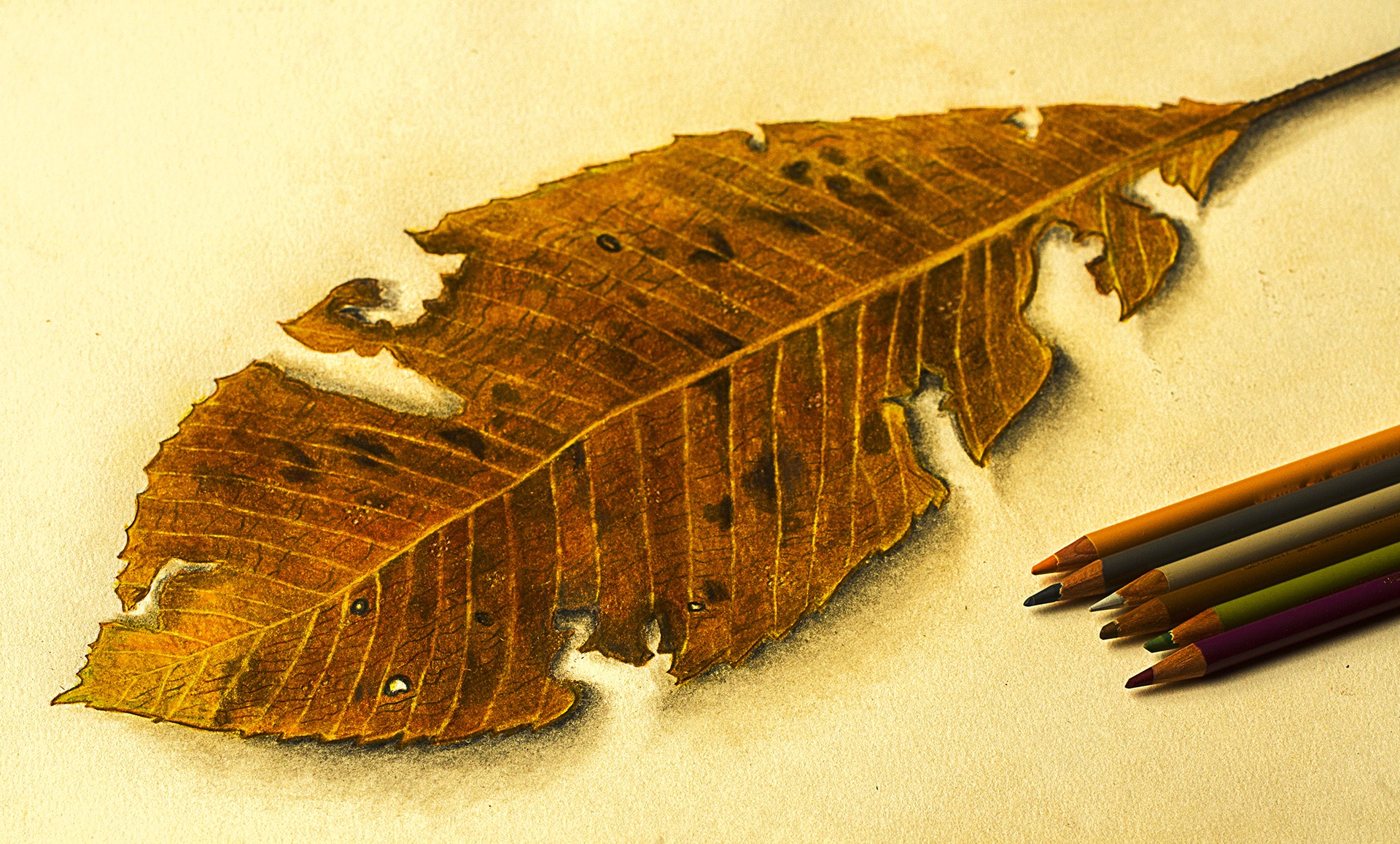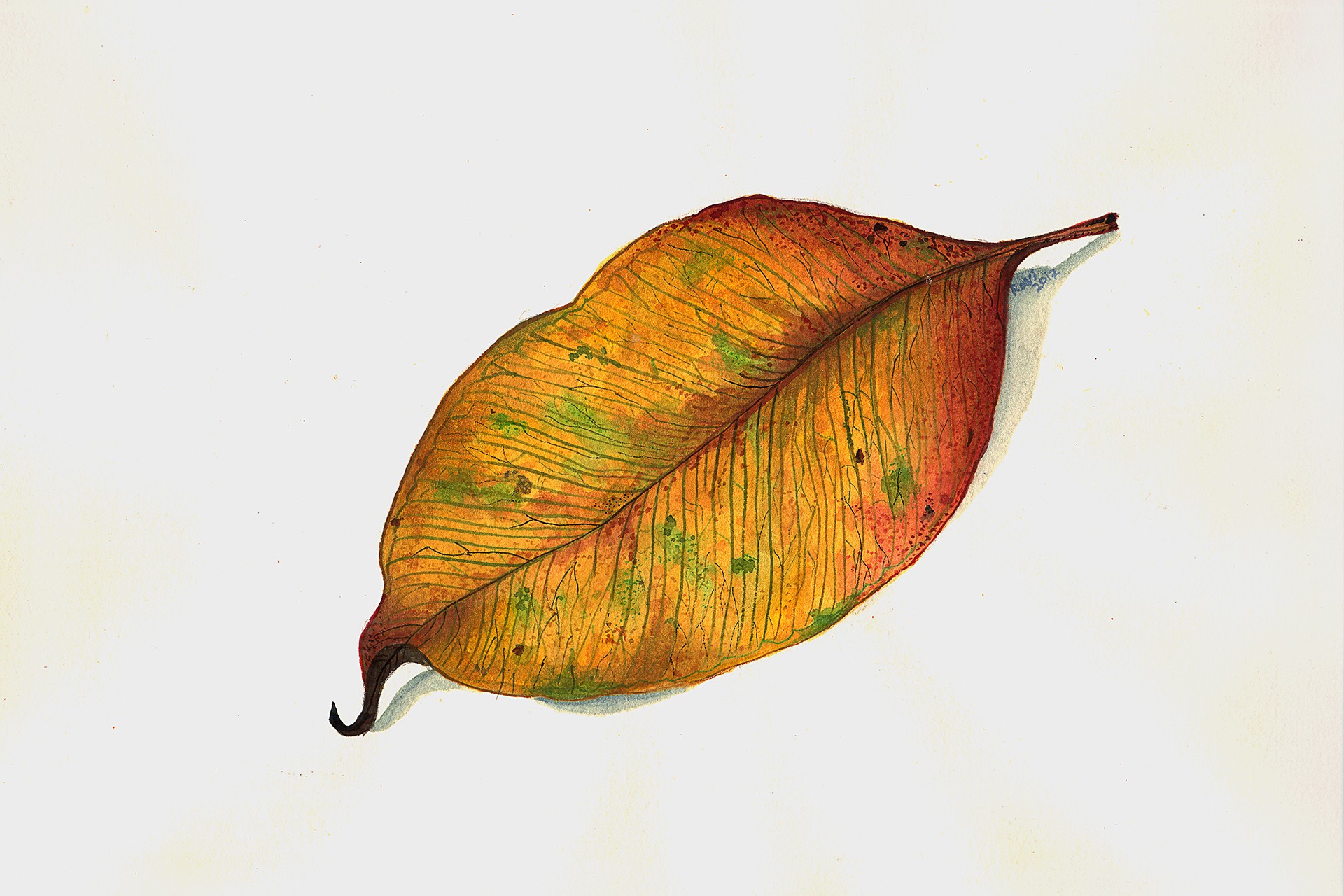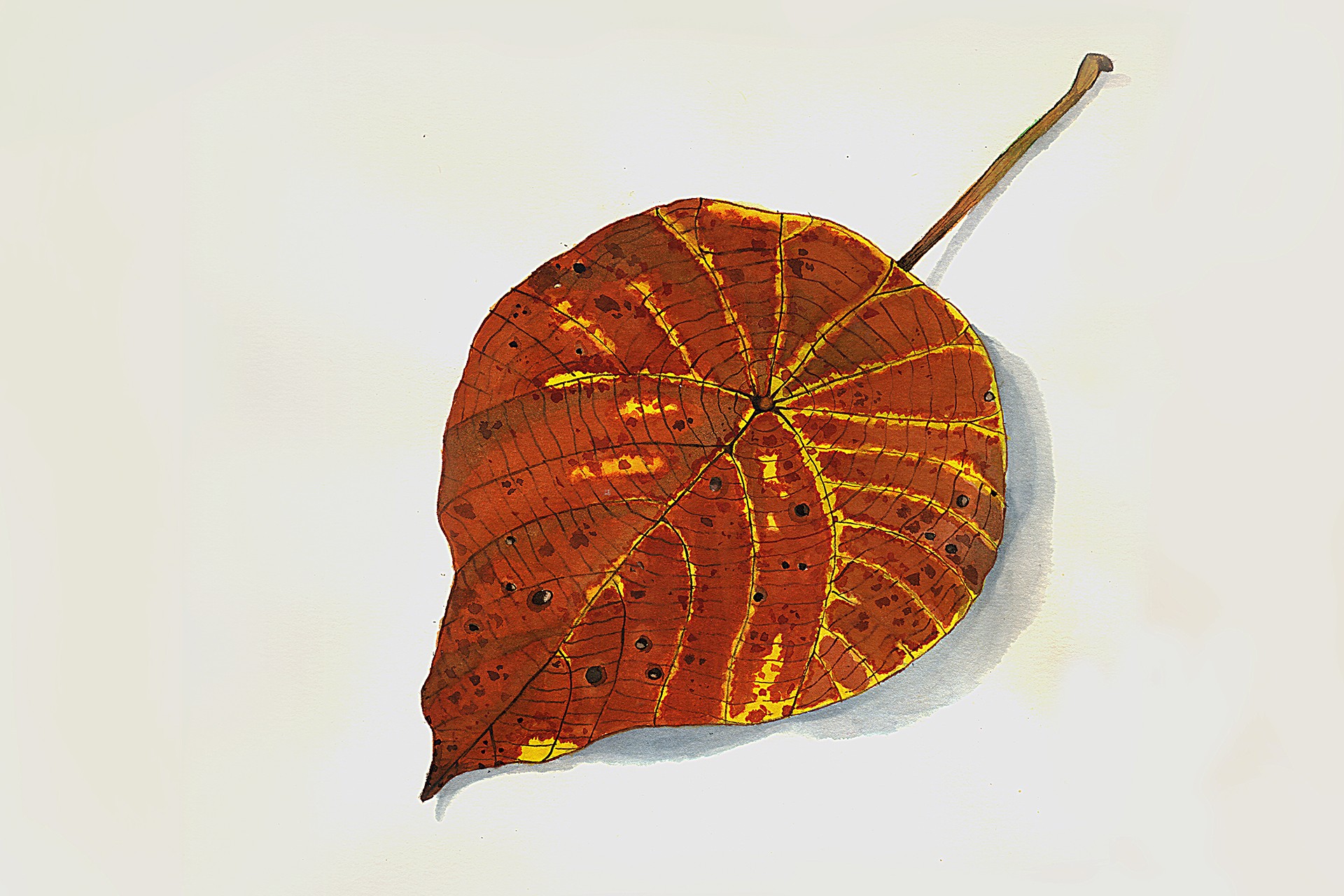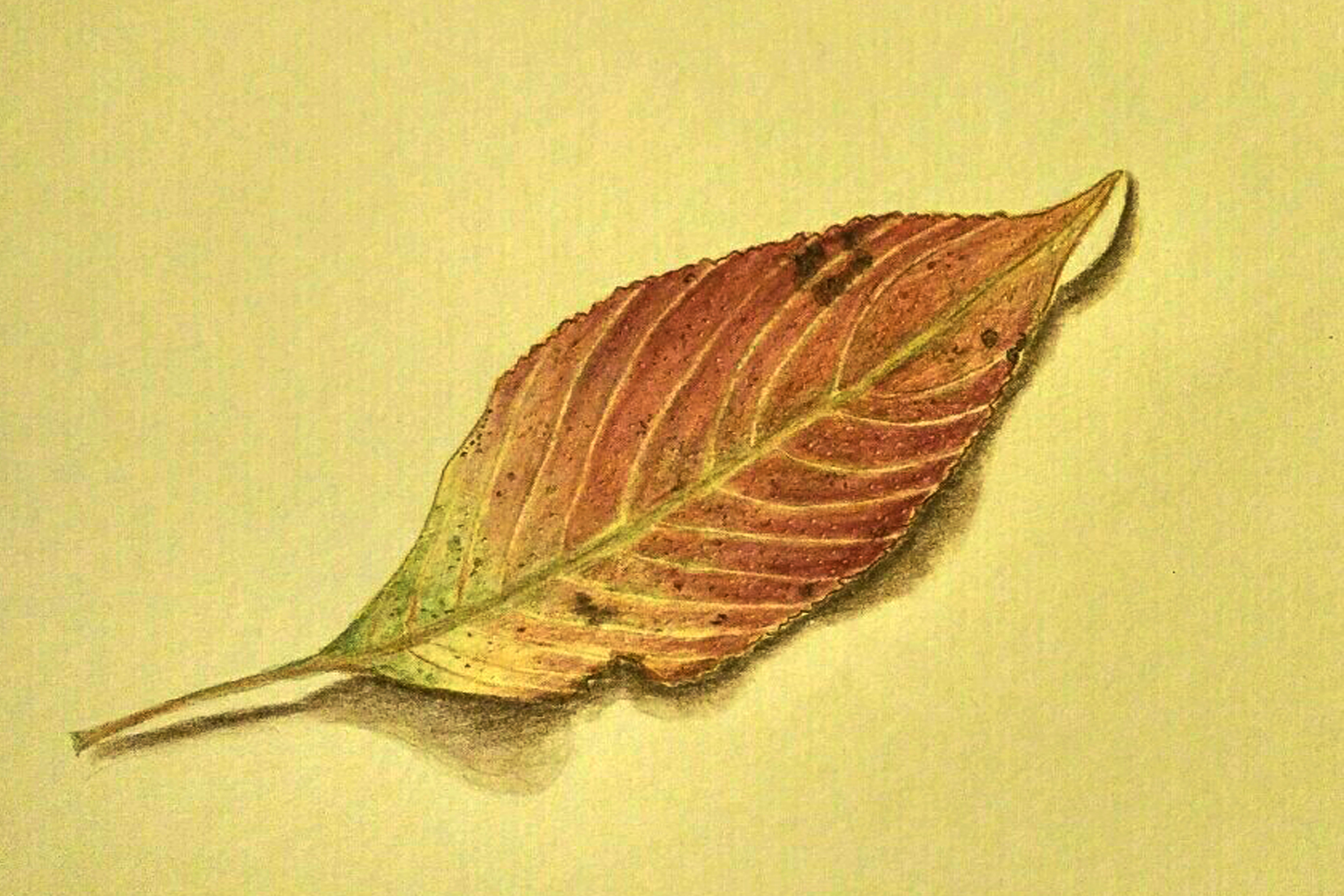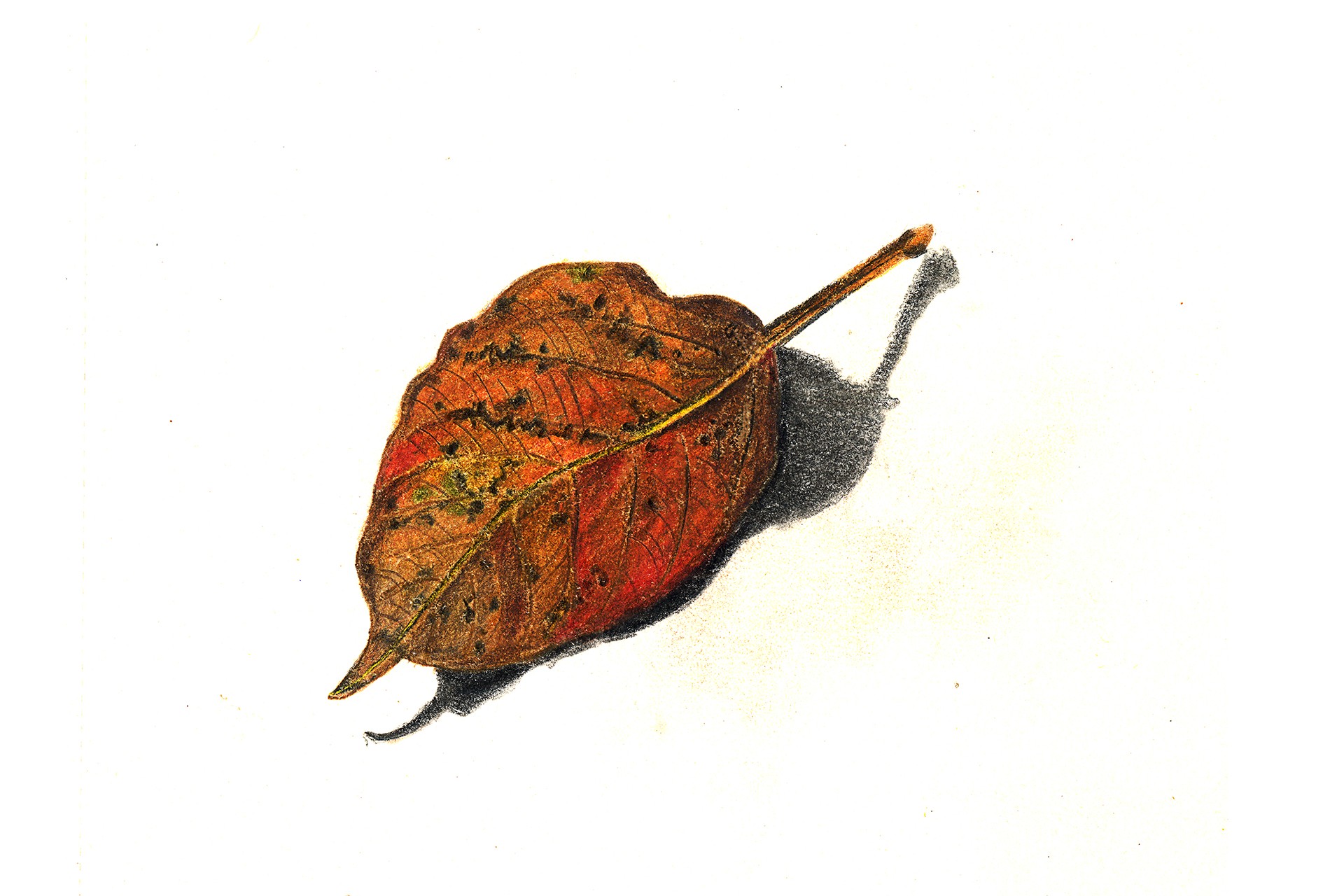If you have ever walked in a forest, it’s hard to miss the verdant greens, the reds and yellows of the tender leaves in the tree canopy. They surround you. But have you tried looking at the forest floor, beneath the undergrowth? Thick, spongy and ultra-rich in organic nutrients, the forest floor hides its own hues, sometimes more vibrant than the canopy itself!
One day, while walking back to my field station after a long day of work (I had just spent hours following and recording butterfly diversity in Chorla Ghats, Goa), something on the forest floor caught my eye. It was a mundane leaf. But on taking a closer look, it was not quite as mundane as I first thought. The leaf, fallen from a nearby tree, was scarlet red, with hints of orange. It stood out starkly in the dull brown leaf litter beneath my feet. I picked it up and thought, “Can the beautiful colours of this dying leaf somehow be captured and immortalised?” The dabbling artist in me said, “Paint it!” And I couldn’t resist. The challenge was accepted.
From that day on, I would bring a leaf back from the forest every day and would try to make a life-size painting of the leaf as accurately as possible. Soon, painting leaves became my favourite pastime. I started to look out for unique leaves, sometimes leaves belonging to particular species. I would often search for endemic plants – the idea of filling colours in a leaf that is found only in the Western Ghats and nowhere else in the world is very exciting to me. Colouring these leaves also gave me a chance to bridge the gap between art and science and draw attention to the beauty of plants, the venation of leaves and the various leaf shapes that we see (and so often overlook) in nature. This painting exercise was also an attempt to highlight the diversity of plant species in the area. The Western Ghats has around 4,000 species of plants and that meant I would never run out of leaves to sketch and paint.
I worked with colour pencils to get those quick and vibrant results but also used classic watercolours. It was a tough task to choose and pin down the colours of the leaf I was painting. The challenge was not only to get the colours right but to work as fast as I could, as the leaves keep changing colour. When you are working so closely on the subject, you can see the colours change even after a few minutes. As they decompose further, they go from yellow or orange to brown or black. I couldn’t preserve the leaves, so the only way I preserved them is through my sketches.
Usually, it would take me anything from one hour to three hours to complete each artwork. In fact, I soon realised that a few hours to complete a painting is a luxury. But the ticking clock, the variations in shape and texture and hue, is what makes it fun for me to paint these leaves and capture their colours on paper for posterity.
Since then, I’ve painted some twenty odd leaves belonging to different species, and even managed to sell a few of them to nature enthusiasts and art collectors. Below, I describe some of the leaves I found that made particularly interesting sketches.
Syzygium cumini
Locally known as Jamun, Syzygium cumini is one of the most common fruiting trees found in the Western Ghats. With simple broad ovate leaves, Jamun is found in both semi-evergreen and evergreen forests and is native to the Indian Subcontinent and adjoining regions of Southeast Asia and China. I picked up this leaf sometime in late January when the tree had just begun to shed its leaves. The leaf shape is broadly ovate aka egg-shaped and it has smooth margins. The leaves vary in size and the leaf lamella or surface can be as broad as 5-6 cm with lengths ranging from 10-12 cm. The venation on the leaves is not prominent, but if you look closely you can see lots of veins running parallel to each other. The leaves of this tree are aromatic and have a nice fruity smell. Jamun has medicinal properties and has many applications in Ayurveda. The seeds are powdered and used to control diabetes. The fruits are rich in antioxidants.
Macaranga peltata
Another broad, big leaf is Macaranga peltata, commonly called as Chanda in Marathi. It is widely distributed in India and Sri Lanka and is usually seen in semi-evergreen and evergreen forests. This is a simple leaf, with a smooth margin – it closely resembles a peepal leaf (Ficus religiosa) but unlike the peepal, the leaf stalk is attached on the lower surface of the leaf, not on the base. The shape of Macaranga leaves is very unique – they are broadly ovate, almost round, and have an acute apex, that is, a narrow pointy end. The leaf lamina is 11-25 cm broad and 9-20 cm long. The secondary veins radiate from the centre of the leaf to the leaf margin. Macaranga is a dioecious tree, meaning there are separate male and female plants and the male and female flowers are borne on different individuals. I sketched this leaf from a tree in Anshi-Dandeli Tiger Reserve, Karnataka, in March. Whenever we would carry breakfast out on the field, my field assistant would make a plate out of these leaves for us to eat our meal.
Strobilanthes callosa
Strobilanthes callosa is a shrub found in the hills of the Western Ghats. It is commonly called Karvi in Marathi. This plant has a very peculiar flowering cycle: it mass flowers every eight years, sets seed and dies. The leaves have crenate margins, meaning the edges of the leaves have blunt, rounded teeth and a rough texture. The wilting leaves sometimes have a reddish orange or a pinkish purple tinge to them and look very pretty. I sketched this leaf in early January last year in Chorla Ghats, Goa.
While sketching this leaf, I wondered how and where all these colours come from. Why do we only see them in the wilting leaves, which have colours ranging from pale green to yellow, to pinks and purples and sometimes black? The green colour in the leaves is, of course, due to chlorophyll, but leaves also contain other chemicals such as carotenoids – the same pigment that gives carrots their orange colour. These oranges and yellows are usually masked by chlorophyll. When chlorophyll breaks down as the leaf ages, the carotenoid pigments are revealed. Some plants also have another set of chemicals called anthocyanins. In plants where anthocyanin coexists with chlorophyll, the leaf colour may run to bronze or sometimes purple. Blackberries and blueberries have high concentrations of anthocyanins – that’s why they appear bluish purple.
Ficus
Ficus is another large genus that is found in the Western Ghats, collectively known as figs. Ficus species such as Ficus benghalensis, Ficus religiosa, Ficus amplissima, etc. are the keystone species of their forest ecosystem. They are some of the most important fruiting species in the forest. A wide range of animal groups starting from insects to birds such as hornbills, parakeets and fruit-eating pigeons, mammals such as fruit bats, civet cats and giant squirrels, and primates such as monkeys and langurs are dependent on Ficus species for food and habitat (roosting, nesting, halting, perching etc.). The fig fruit is an enclosed inflorescence, sometimes referred to as a syconium, an urn-like structure lined on the inside with the fig's tiny flowers. The unique fig pollination system involving tiny, highly specific wasps known as fig wasps that enter via a small opening in these sub-closed inflorescences to both pollinate and lay their own eggs, has been a constant source of inspiration and wonder to biologists. The leaves have smooth margins and have a leathery texture. The wilting leaves sometimes have a reddish orange or a pinkish purple tinge to them and look very pretty.
I hope these leaf sketches – my tribute to the hidden colours on the forest floor – inspire you to look down the next time you are on a forest trail, and see the beauty hidden in the leaf litter. It’s not just wilted leaves; there is far more beneath your feet: insects, mushrooms, beautiful flowers... so go on, explore the jungles yourself!
With this illustrated story, we encourage you to look down when you are out in nature. Check out our canopy series, where we tell you why you should look up as well.
